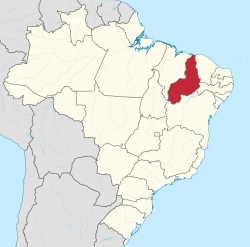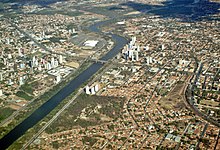Piauí
| Piauí | |||
|---|---|---|---|
| Symbols | |||
|
|||
| Basic data | |||
| Country | Brazil | ||
| Capital | Teresina | ||
| surface | 251,616.8 km² | ||
| Residents | 3,273,227 (estimate as of July 1, 2019) | ||
| density | 13 inhabitants per km² | ||
| ISO 3166-2 | BR-PI | ||
| economy | |||
| GDP | 5575 million R $ 1703 R $ per person (2001) |
||
Coordinates: 7 ° S , 43 ° W
Piauí , officially Portuguese Estado do Piauí , is a state in the northeast of Brazil . The population on July 1, 2019 was estimated at 3,273,227.
geography
Piauí borders the Brazilian states of Ceará , Pernambuco , Bahia and Maranhão .
Piauí is the third largest state in the northeast. Located in a transition area, Piauí has different landscapes with specific climates and different vegetation.
The only 66 kilometers long coast has mangrove forests and a tropical climate with tolerable temperatures. In contrast, the interior is characterized by a semi-arid climate and high temperatures. The rainy season lasts from December to April. Savannahs and steppes, cerrados, and arid areas with bush and thorns dominate.
history
Piauí is the only state in the northeast where settlement was from inland. At the end of the 17th century, cattle breeders settled in search of new pastures. Huge cattle ranches soon sprang up. After the Jesuits were driven out, many farms fell back to Portugal and were abandoned.
politics
In the elections in Brazil in 2018 , here in the gubernatorial elections for the executive branch , Wellington Dias des Partido dos Trabalhadores (PT) was re-elected as the 52nd governor for the period from 2019 to 2023. He had held this office since 2015. Vice-governor is Regina Sousa (PT).
The legislature is exercised by 30 elected deputados estaduais in the Legislative Assembly of Piauí . The state sends 10 Federal MPs ( Deputados federais ) into the House of Representatives and three Federal Senate in the Federal Senate of the National Congress .
population
Cities
As of July 1, 2019, Piauí has a total of 224 individual cities, the municípios . The largest cities are estimated with their population as of July 1st, 2019:
| city | rank | Residents | |
|---|---|---|---|

|
Teresina | 1 | 864.845 |

|
Parnaíba | 2 | 153.078 |

|
Picos | 3 | 78.222 |

|
Piripiri | 4th | 63,742 |

|
Floriano | 5 | 59,935 |

|
Barras | 6th | 47,066 |

|
Campo Maior | 7th | 46,833 |
| União | 8th | 44,485 | |

|
Altos | 9 | 40,524 |

|
Esperantina | 10 | 39,737 |
economy
Piauí is one of the poorest states. Around half of the population lives in cities. There is no industry to speak of. With tax incentives it was at least possible to improve the infrastructure. Agriculture is dominated by cattle breeding; beans, corn , rice , cassava , soybeans and sugar cane are grown , but not in sufficient quantities.
literature
- Hamilton Reis de Oliveira, Leonardo Dias: Nordeste do Brasil. Sinopse Estatística 2014. Banco do Nordeste do Brasil, Fortaleza 2014, ISBN 978-85-7791-238-7 . (PDF; 4.1 MB)
- history
- Odilon Nunes: Pesquisas para a história do Piauí. 4 volumes. Artenova, Rio de Janeiro 1975-1976.
- Francisco Augusto Pereira da Costa: Chronologia histórica do Estado do Piauhy. Editora artenova, Rio de Janeiro 1974. Reprint. Contains the story of Piauí up to 1889. ( digitized version )
Web links
- Official Website (Brazilian Portuguese)
Individual evidence
- ↑ a b c Piauí - Panorama. In: cidades.ibge.gov.br. IBGE , accessed September 4, 2019 (Brazilian Portuguese).




